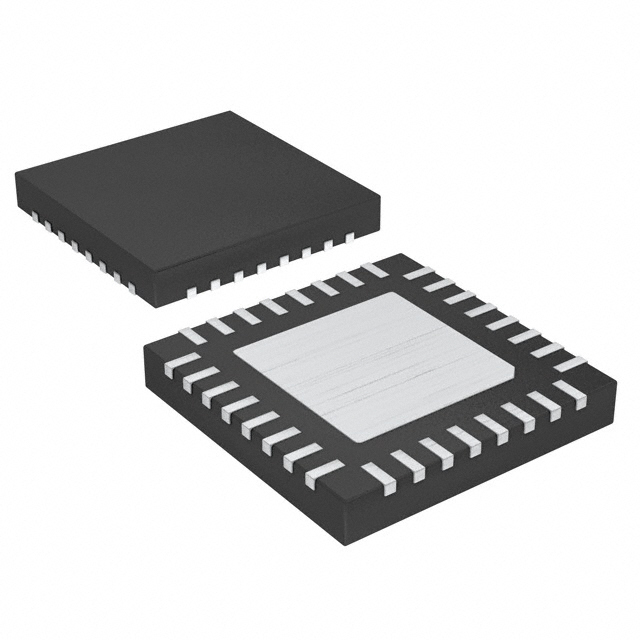Lihat spesifikasi untuk detail produk.

ATMEGA328PB-MN
Product Overview
Category
ATMEGA328PB-MN belongs to the category of microcontrollers.
Use
It is commonly used in various electronic devices and embedded systems for controlling and processing data.
Characteristics
- Low power consumption
- High-performance 8-bit AVR microcontroller
- Enhanced features compared to its predecessor, ATMEGA328P
- Wide operating voltage range
- Large program memory size
- Multiple communication interfaces
Package
ATMEGA328PB-MN is available in a compact package, making it suitable for space-constrained applications.
Essence
The essence of ATMEGA328PB-MN lies in its ability to provide efficient and reliable control and processing capabilities for electronic devices.
Packaging/Quantity
ATMEGA328PB-MN is typically packaged in trays or reels, with quantities varying based on customer requirements.
Specifications
- Architecture: 8-bit AVR
- Flash Memory: 32KB
- SRAM: 2KB
- EEPROM: 1KB
- Operating Voltage: 1.8V - 5.5V
- Maximum Clock Frequency: 20MHz
- Digital I/O Pins: 23
- Analog Input Pins: 6
- Communication Interfaces: UART, SPI, I2C
- Timers/Counters: 3
- PWM Channels: 6
- ADC Resolution: 10-bit
- Operating Temperature Range: -40°C to +85°C
Detailed Pin Configuration
The ATMEGA328PB-MN microcontroller has a total of 32 pins, each serving a specific purpose. The pin configuration is as follows:
- Pins 1-7: Digital I/O Pins (D0-D7)
- Pins 8-14: Digital I/O Pins (D8-D13)
- Pin 15: Analog Reference (AREF)
- Pins 16-17: Analog Input Pins (A0-A1)
- Pins 18-21: Digital I/O Pins (A2-A5)
- Pin 22: Reset (RESET)
- Pins 23-30: Ground (GND)
- Pins 31-32: Power Supply (VCC)
Functional Features
1. Enhanced Performance
The ATMEGA328PB-MN offers improved performance compared to its predecessor, with a higher clock frequency and increased memory capacity.
2. Low Power Consumption
This microcontroller is designed to operate efficiently with low power consumption, making it suitable for battery-powered devices.
3. Multiple Communication Interfaces
ATMEGA328PB-MN supports UART, SPI, and I2C interfaces, enabling seamless communication with other devices and peripherals.
4. Rich I/O Capability
With a total of 23 digital I/O pins and 6 analog input pins, this microcontroller provides flexibility in connecting and controlling external components.
Advantages and Disadvantages
Advantages
- Improved performance compared to previous models
- Low power consumption for energy-efficient applications
- Wide operating voltage range allows compatibility with various power sources
- Multiple communication interfaces enhance connectivity options
- Ample program memory size for complex applications
Disadvantages
- Limited number of analog input pins may restrict certain applications requiring more analog inputs
- Lack of built-in Wi-Fi or Bluetooth connectivity, which may require additional components for wireless communication
Working Principles
ATMEGA328PB-MN operates based on the principles of an 8-bit AVR microcontroller. It executes instructions stored in its flash memory, processes data, and controls the connected devices based on the program logic. The microcontroller interacts with external components through its I/O pins and communication interfaces.
Detailed Application Field Plans
ATMEGA328PB-MN finds applications in various fields, including but not limited to:
- Home Automation: Controlling and monitoring smart home devices such as lights, thermostats, and security systems.
- Industrial Automation: Managing and controlling machinery and equipment in manufacturing processes.
- Internet of Things (IoT): Enabling connectivity and data processing for IoT devices.
- Robotics: Providing control and decision-making capabilities for robotic systems.
- Automotive Electronics: Controlling various functions in automotive systems, such as engine management and infotainment.
Detailed and Complete Alternative Models
Some alternative models that offer similar functionality to ATMEGA328PB-MN are:
- ATMEGA328P: The predecessor of ATMEGA328PB-MN, offering comparable features with slightly lower performance.
- PIC16F877A: A microcontroller from Microchip with similar capabilities, widely used in embedded systems.
- STM32F103C8T6: An ARM-based microcontroller from STMicroelectronics, providing enhanced performance and extensive peripheral options.
These alternative models can be considered based on specific project requirements and compatibility with existing systems
Sebutkan 10 pertanyaan dan jawaban umum terkait penerapan ATMEGA328PB-MN dalam solusi teknis
Sure! Here are 10 common questions and answers related to the application of ATMEGA328PB-MN in technical solutions:
Q: What is ATMEGA328PB-MN? A: ATMEGA328PB-MN is a microcontroller from the AVR family, manufactured by Microchip Technology. It is widely used in various technical solutions.
Q: What are the key features of ATMEGA328PB-MN? A: Some key features of ATMEGA328PB-MN include 32KB flash memory, 2KB SRAM, 23 general-purpose I/O pins, multiple communication interfaces (UART, SPI, I2C), and built-in analog-to-digital converters (ADC).
Q: Can ATMEGA328PB-MN be used for IoT applications? A: Yes, ATMEGA328PB-MN can be used for IoT applications. Its low power consumption, multiple communication interfaces, and sufficient memory make it suitable for connecting devices to the internet.
Q: How can I program ATMEGA328PB-MN? A: ATMEGA328PB-MN can be programmed using various development tools such as Atmel Studio, Arduino IDE, or other compatible programming environments.
Q: Can I use ATMEGA328PB-MN for motor control applications? A: Yes, ATMEGA328PB-MN can be used for motor control applications. It has PWM (Pulse Width Modulation) outputs that can be utilized for controlling motors.
Q: Is ATMEGA328PB-MN suitable for battery-powered devices? A: Yes, ATMEGA328PB-MN is suitable for battery-powered devices due to its low power consumption capabilities. It offers sleep modes and power-saving features to optimize energy usage.
Q: Can I interface ATMEGA328PB-MN with external sensors? A: Yes, ATMEGA328PB-MN can be easily interfaced with various external sensors such as temperature sensors, humidity sensors, motion sensors, etc., using its GPIO pins or communication interfaces.
Q: What is the maximum clock frequency of ATMEGA328PB-MN? A: The maximum clock frequency of ATMEGA328PB-MN is 20 MHz when powered by an external crystal oscillator.
Q: Can I use ATMEGA328PB-MN for real-time applications? A: While ATMEGA328PB-MN does not have a dedicated real-time clock (RTC), it can still be used for many real-time applications by utilizing timers and interrupts effectively.
Q: Are there any development boards available for ATMEGA328PB-MN? A: Yes, there are several development boards available for ATMEGA328PB-MN, including Arduino Uno, Arduino Nano, and custom-made boards specifically designed for this microcontroller.
Please note that these answers are general and may vary depending on specific requirements and implementations.

